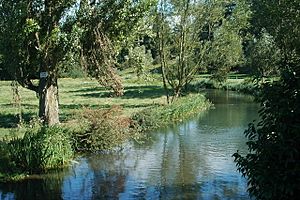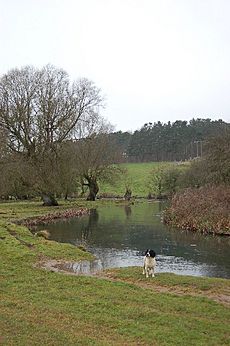River Coln facts for kids
Quick facts for kids River Coln |
|
|---|---|

River Coln south of Coln St Aldwyns, Gloucestershire
|
|
| Country | England |
| Counties | Gloucestershire |
| Towns | Fairford |
| Physical characteristics | |
| Main source | Brockhampton, Gloucestershire 51°54′36″N 1°57′04″W / 51.910°N 1.951°W |
| River mouth | River Thames Lechlade, Gloucestershire 51°41′17″N 1°42′18″W / 51.688°N 1.705°W |
| Discharge (location 2) |
|
| Discharge (location 3) |
|
The River Coln is a beautiful river that flows through Gloucestershire, England. It starts its journey north of a village called Brockhampton, which is east of Cheltenham. From there, it winds its way south-east through the lovely Cotswold Hills.
The river passes through several charming villages and towns. These include Andoversford, Withington, Fossebridge, Bibury, Coln St Aldwyns, Quenington, and Fairford.
Contents
Journey to the Thames
The River Coln eventually joins the famous River Thames. This meeting point is south-west of Lechlade. Here, it also meets the Thames and Severn Canal near a spot called The Round House Footbridge.
Historical Landmarks
As the River Coln flows between Withington and Fossebridge, it passes by an amazing historical site: Chedworth Roman Villa. This ancient Roman house shows how people lived thousands of years ago.
Cotswold Water Park
Near Fairford and Lechlade, there used to be many large gravel pits. These pits are now filled with water and form the eastern part of the Cotswold Water Park. The River Coln helps to feed and drain these lakes. It's a great place for water sports and enjoying nature!
River Life: Fish and More
The River Coln is home to many different kinds of freshwater fish. You can find beautiful brown trout swimming in its waters. Another interesting fish that lives here is the grayling. These fish need clean, healthy water to thrive.
Water Health Check
Experts at the Environment Agency regularly check how healthy the rivers in England are. They want to make sure the water is clean enough for all the plants and animals that live there. They look at things like the types of tiny creatures and plants in the water, and if there are any harmful chemicals. This helps them understand if the river is doing well or if it needs help to be cleaner.


